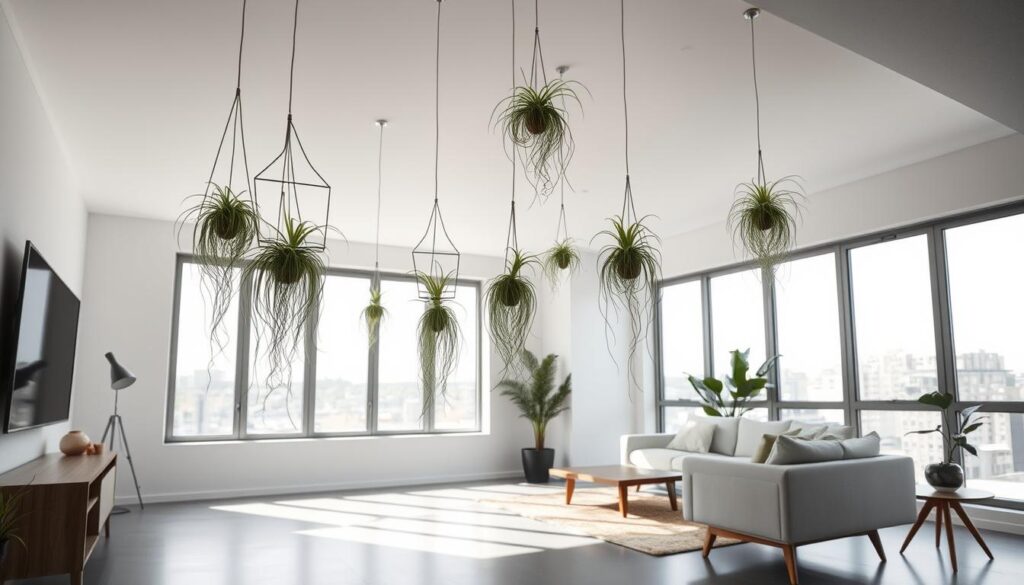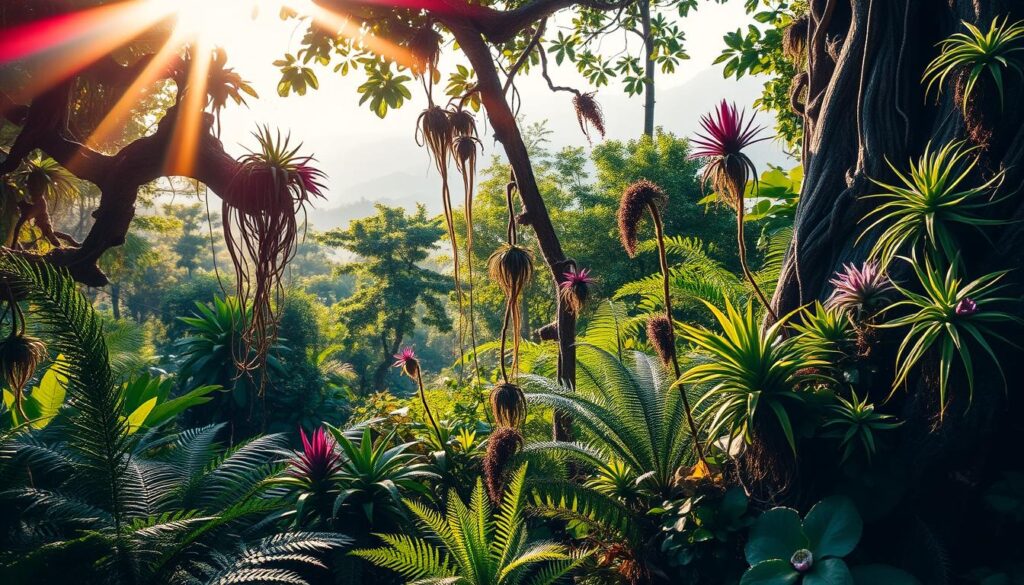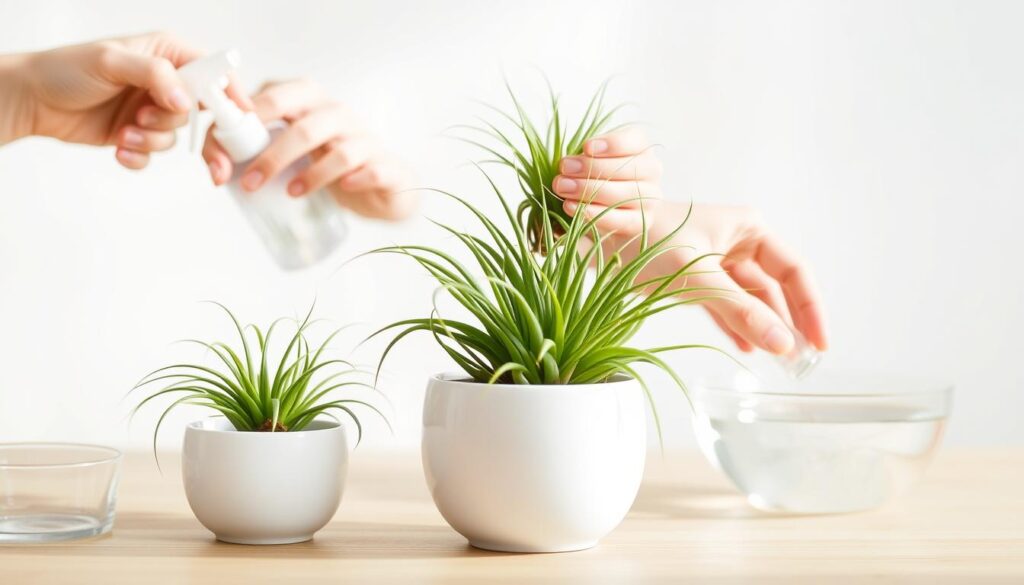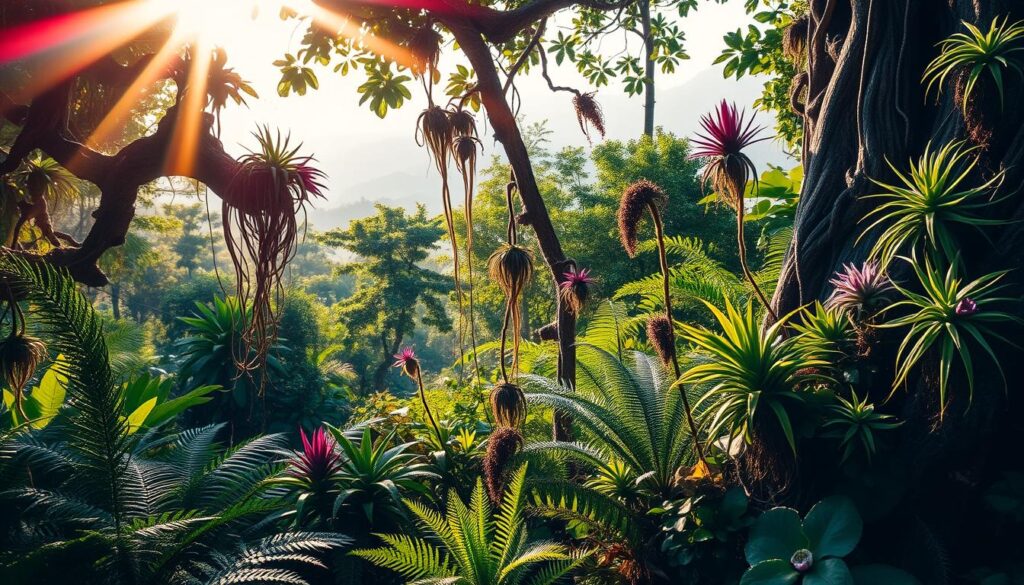Imagine a plant that needs no soil, no heavy pots, and almost no maintenance. Meet Tillandsia, the air plant—a natural wonder that defies traditional plant care. These unique houseplants survive by absorbing moisture and nutrients directly from the air. They are perfect for anyone eager to add greenery without the hassle.

Air plants belong to the Tillandsia genus, a group of epiphytes that grow on trees or rocks in the wild. Their ability to thrive without soil makes them a trending choice for modern homes, offices, and creative spaces. Whether mounted on driftwood, placed in glass orbs, or simply displayed freely, these plants bring life to any room.
Key Takeaways Plant That Thrives on Air
- Air plants (Tillandsia) are plants that grow without soil, relying on the environment for survival.
- They are low-maintenance unique houseplants ideal for those new to gardening.
- Native to forests and deserts, these plants adapt to indoor settings effortlessly.
- Their care focuses on air circulation and occasional misting, not traditional watering.
- Air plants add style to spaces while challenging conventional plant expectations.
Introduction to Tillandsia: The Air Plant Wonder
Tillandsia species are part of the bromeliad family. They are epiphytic plants that don’t need soil to live. Instead, they stick to surfaces and get nutrients from the air. This makes them a natural wonder.
What Makes Tillandsia Different from Other Plants
These plants have special leaves with tiny scales called trichomes. These scales catch moisture and minerals from rain or fog. Their roots hold them in place, not absorbing nutrients. This lets them grow in places other plants can’t.
The Fascinating History of Air Plant Discovery
Early explorers found Tillandsia species in the 1700s in the Americas. Botanists like Carl Linnaeus were amazed by their ability to live without soil.
“These plants break all rules of conventional botany,” remarked one 18th-century naturalist, noting their ability to live on nothing but air.
Over time, scientists have found over 650 Tillandsia species. Each one has adapted to its own climate.
How Air Plants Have Adapted to Their Environment
Tillandsia’s adaptation is crucial for their survival. Their trichomes catch water, and curled leaves store it. Some change leaf color to avoid overheating. These traits help them survive in dry areas, showing nature’s creativity.
The Plant That Grows Without Water or Sunlight: Science Explained
Behind the air plant’s survival lies a mix of biology and adaptation. This section breaks down the air plant science behind their unique traits.
Understanding Trichomes: The Secret Behind Air Plant Survival
Plant trichomes are tiny scales covering their surfaces. These structures act like tiny sponges, soaking moisture from the air. Plant That Thrives on Air, Under a microscope, they look feathery, increasing surface area for absorption. This feature lets them thrive without soil.
- Collect water from humidity
- Capture dust particles for nutrients
- Protect from drying out
How Air Plants Absorb Atmospheric Nutrients
Plant That Thrives on Air – They gather atmospheric nutrients from dust, pollutants, and rain. Research shows they pull minerals from airborne particles. These nutrients fuel growth without soil. Here’s how they work:
- Moisture from humidity
- Minerals from dust
- Pollen particles
The Minimal Requirements for Tillandsia Survival
Though called “air plants,” they still need basic conditions. Here’s what they require compared to regular plants:
| Need | Air Plants | Regular Plants |
|---|---|---|
| Water | Mist weekly | Regular watering |
| Light | Indirect light | Full sun/shade |
| Soil | None required | Necessary |
These minimal plant care rules make them perfect for busy homes.
Common Types of Air Plants and Their Characteristics
Exploring Tillandsia varieties opens up a world of unique shapes and colors. Air plants like Tillandsia ionantha are popular in homes and gardens across the U.S. Knowing how to identify air plants helps gardeners pick the right one for their space, Plant That Thrives on Air.
- Tillandsia ionantha: Its bright pink blooms and small size (3–5 inches) make it a favorite. Its vibrant colors show it’s flowering, and it’s great for beginners.
- Tillandsia xerographica: This species has silvery leaves and can handle drought well. It prefers brighter light and occasional misting.
- Tillandsia bulbosa: It has unique bulb-like bases that store water, and curly leaves that trap moisture. Its blooms have red or purple bracts.
Identifying these species starts with looking at leaf texture and growth patterns. Tillandsia ionantha has soft, fuzzy leaves, while xerographica’s leaves are rigid and spiky. Size also matters—bulbosa’s swollen base contrasts with the slender xerographica. Most varieties need similar care but differ in light preferences. For example, ionantha tolerates low light better than xerographica, Plant That Thrives on Air.
Beginners can start with hardy species like ionantha, while collectors might seek rare forms. Always check bloom cycles and leaf health to ensure proper care. With this guide, discovering popular air plants becomes easier—whether you’re styling a desk display or expanding a collection.
The Natural Habitat of Tillandsia Species

Plant That Thrives on Air – Air plants live in special air plant habitats shaped by millions of years. These tropical plants are experts at adapting. They need places where sunlight filters through trees and breezes carry moisture.
Geographic Distribution Around the World
Most Tillandsia species live in the Americas. Plant That Thrives on Air – Key places include:
- Central/South America: From Mexico’s cloud forests to Brazil’s rainforests
- Caribbean Islands: Jamaica and Puerto Rico have many air plants
- US South: Florida and Texas have native air plants
How Air Plants Thrive in Their Native Environments
Survival depends on four key things in their native plant environments:
| Factor | Ideal Conditions |
|---|---|
| Humidity | 60–80% (kept up by mist and dews) |
| Temperature | 60–90°F (15–32°C) all year |
| Light | Indirect sunlight (50–70% shade) |
| Airflow | Constant gentle breezes for moisture |
Ecological Importance in Their Natural Ecosystems
As rainforest epiphytes, they are crucial. They:
- Provide homes for insects and fungi
- Help keep forest humidity by capturing moisture
- Support biodiversity by hosting tiny ecosystems
“Each air plant acts as a tiny ecosystem engineer,” says Dr. Maria González, a botanist at Costa Rica’s Tropical Research Institute. “They sustain life even in tree canopies.”
Knowing these wild habitats helps us care for air plants at home. We can mist them like dew or use bright but filtered light, Plant That Thrives on Air.
Debunking Myths: Do Air Plants Really Need Nothing?
Many think air plants live off air alone. But, air plant myths often lead to neglect. They actually need water and light to thrive. Let’s clear up the confusion.
Watering air plants is crucial. They absorb moisture through their leaves, not soil. To keep them hydrated, mist, soak, or dunk them. In dry places, weekly soaks are best. But, avoid too much water to prevent rot, Plant That Thrives on Air.
Plant That Thrives on Air – Lighting is also important. Air plants need bright, indirect light for photosynthesis. Direct sun can burn their leaves, while dark spots make them dormant. East or north-facing windows are perfect for filtered light. Rotate your plants weekly for balanced growth, Plant That Thrives on Air.
- Myth: Sealed terrariums are perfect homes. Reality: Air circulation is key to prevent mold.
- Myth: Fertilizer is unnecessary. Reality: Monthly diluted fertilizer boosts health.
By debunking these myths, you can give your air plants the care they need. A bit of knowledge can make a big difference in keeping them healthy and thriving, Plant That Thrives on Air.
How to Care for Your Air Plant at Home
Learning the air plant care guide basics is key to your Tillandsia’s health. Start with a simple air plant watering schedule. Soak plants in room-temperature water 2-3 times a week. Then, shake off extra water and let them dry in indirect light, Plant That Thrives on Air.

- Watering: Soak plants for 20-30 minutes. In dry places, mist them between soaks. Watch for curled or soggy leaves, which mean too much water.
- Light: Keep them in bright, filtered light. Direct sunlight can burn their leaves. Rotate them weekly for balanced growth.
- Humidity: Mist them weekly if your home is dry. Grouping them with other indoor plant care plants can also help, Plant That Thrives on Air.
| Season | Watering | Light | Humidity Tips |
|---|---|---|---|
| Spring/Summer | Soak 2-3x weekly | Indirect bright light | Mist daily in arid climates |
| Winter | Reduce to 1x weekly | Supplement with grow lights if dim | Use humidifiers if heating dries air |
Fertilize them lightly with a balanced orchid fertilizer once a month. If you see browning tips, it’s a sign they need more water. With regular Tillandsia maintenance, these plants will thrive and add beauty to your space.
“Air plants adapt, but they’re not zero-effort. A little attention goes a long way.”
Creative Ways to Display and Enjoy Tillandsia
Make your space pop with air plant display ideas that highlight Tillandsia. These plants fit right into modern Tillandsia decor. Plant That Thrives on Air – They work well in any style, from simple to bold.
Hanging Air Plant Displays for Your Home
Hang air plants to add vertical flair. Here are some creative plant displays:
- Wrap in macramé cord for a bohemian look
- Suspend glass orbs filled with water for hydration and style
- Mount on wooden plaques for a rustic vibe
Place them near windows for soft light. Direct sun can harm their leaves, Plant That Thrives on Air.
Terrariums and Glass Containers for Air Plants
Make air plant terrariums that look good and care for the plants. Here’s how:
- Use open-topped glass jars or bowls
- Add decorative gravel or seashells for texture
- Place plants so roots aren’t covered
Plant That Thrives on Air – Turn them weekly for even light. Don’t use closed jars to prevent rot.
Combining Air Plants with Other Decor Elements
Match Tillandsia with your decor for a unified look:
- Cluster with geodes on shelves
- Weave into wreaths or wall hangings
- Arrange in gallery-style groupings
They look great with both simple and bold decor. They’re easy to care for and add flair.
Troubleshooting Common Air Plant Problems
Brown air plant tips or drooping leaves? Many gardeners face air plant problems when first caring for these unique plants. Don’t panic—most issues are fixable with timely action. Let’s break down solutions for the most frequent challenges – Plant That Thrives on Air.
Overwatering is a top culprit. If your plant has yellowing bases or mushy spots, it’s likely drowning. Reviving dying air plants starts by air-drying them completely for 24-48 hours. Reduce misting and ensure they get airflow. Underwatering shows as crispy tips—soak affected plants in room-temperature water for 1-3 hours weekly.
- Pests: Check for fuzzy white mealybugs or tiny scale insects. Gently scrub them off with a cotton swab dipped in rubbing alcohol. For severe cases, isolate the plant and treat with insecticidal soap.
- Brown tips: Trim dried edges with clean scissors. Move plants away from direct heat sources like vents to prevent drying out.
- Environmental stress: Avoid placing air plants near AC units or in full sun. Opt for indirect light and humidity trays to balance their surroundings.
“Patience is key—air plants respond slowly to care adjustments,” advise indoor plant experts at The Sill. “Check your plant weekly and adjust one care factor at a time.”
If blooms drop, don’t worry—it’s natural. Focus on strengthening the parent plant to encourage new growth. With these steps, even struggling plants can rebound. Remember: most plant pests and brown tips are early warnings, not final warnings. Stay observant and act early – Plant That Thrives on Air.
Air Plants in Modern Design and Sustainability
As cities grow and people care more about the planet, air plants are becoming popular. They fit well with modern interior design because they need little care. This makes them perfect for today’s homes, Plant That Thrives on Air.
Why Air Plants Are Perfect for Urban Living
Plant That Thrives on Air – In cities, space and time can be tight. Air plants don’t need soil and can grow in small places. They’re great for those who rent or are busy.
They also add a touch of green without taking up too much room.
The Growing Popularity of Tillandsia in Interior Design
Designers and blogs like Architectural Digest are now using air plants. A 2023 study shows a 30% increase in Tillandsia sales for decoration. Plant That Thrives on Air, Interior designer Lena Torres says, “They’re the ultimate low-maintenance statement.”
“Their airy forms pair well with concrete or metal, balancing modern aesthetics with nature.”
Environmental Benefits of Growing Air Plants
- Require zero pesticides or fertilizers
- Use 90% less water than soil-based plants
- Carbon-neutral option for eco-friendly plants
Look for air plants from nurseries like Costa Farms. They grow them through division, not by taking from the wild. This way, you get sustainable houseplants without harming nature.
Conclusion: Plant That Thrives on Air
Air plants show us nature’s endless creativity. These unique houseplants defy old ideas about plant survival. They use special leaves to get moisture and light, proving evolution’s cleverness, Plant That Thrives on Air.
From their beginnings in forests and deserts to becoming botanical wonders in homes, tillandsias teach us a valuable lesson. Life can thrive even in tough conditions.
Air plants bring life to any space without much effort. They fit well with today’s fast-paced lives, making them great for any plant collection. Plant That Thrives on Air – Scientists and designers are finding new ways to use them in green living spaces.
Starting with one air plant can open your eyes to the natural world. They inspire wonder and need little care. Whether you’re new to plants or have many, these botanical wonders challenge our views on plants and where they can grow. Let their magic change how you see life, one leaf at a time, Plant That Thrives on Air.
FAQ
What are air plants and how do they work?
Air plants, also known as Tillandsia, don’t need soil to grow. They get moisture and nutrients through special leaves called trichomes. This lets them live in many places.
How often should I water my air plant?
Water your air plants once a week. But in hot or dry places, mist them more or soak them for 30 minutes. This keeps them moist.
Can air plants survive in low light conditions?
Air plants can handle low light but need indirect sunlight. A bright, filtered window is best. Direct sun can dry them out.
Do air plants need fertilizer?
Yes, air plants need fertilizer! Use a bromeliad or air plant fertilizer every 4-6 weeks. Dilute it to half strength before applying.
Are air plants safe for pets?
Most air plants are safe for pets. But watch your pets, as some might chew on plants.
What are the best types of air plants for beginners?
Beginners should start with Tillandsia ionantha and Tillandsia xerographica. They’re easy to care for and grow well.
How can I display air plants creatively at home?
Show off air plants in terrariums, hanging planters, or wooden mounts. Make sure they get air and light while looking good.
What should I do if my air plants are turning brown?
Brown leaves mean your plants might not be getting enough water or too much sun. Check their environment and care. A soak or move might help.
How do I propagate my air plants?
Propagate air plants by removing offsets, or “pups.” Wait until they’re one-third the size of the parent. Then, twist them off and place them in a light, humid spot.
Source link
- https://www.bhg.com/gardening/houseplants/care/grow-air-plants/
- https://www.southernliving.com/garden/air-plants
- https://www.gardenista.com/posts/10-things-nobody-tells-you-about-air-plants-tillandsias/
- https://apnews.com/article/c249ab5f63dfd62a8af362589e28894d
- https://www.airplantcity.com/pages/air-plant-care
